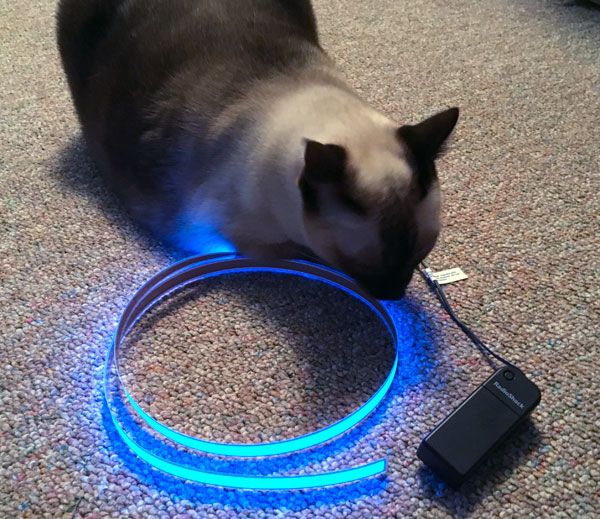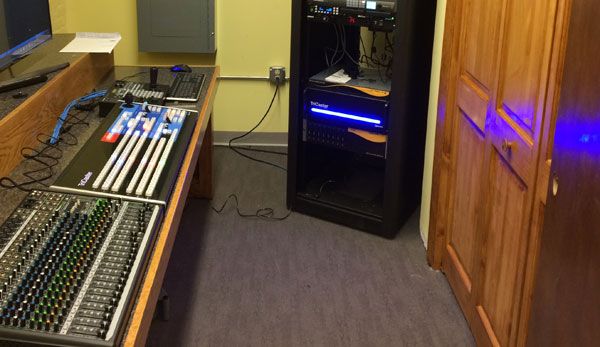Maybe they just turned it off for that scene?
JB
JB
And The Menagerie, I assume?They did do rear projection occasionally, most notably in "Spock's Brain".

While not the answer to the Enterprise main viewscreen—since solid state electro-luminescent (el) products did not exist in the 1960s—el material can be found in a variety of forms today. You can outline your TV with it, strap the remote to the armrest of your favorite captain's chair, and enjoy your own private Idaho, er, Enterprise right in your living room.

Ellie had to get into the shot when she thought her name was mentioned (or thought—I have a mind reading cat).
And The Menagerie, I assume?
that's the only time Kirk and Spock ever saw an episode of Star Trek.


I would consider it a kindness to refrain from using S#E# notation for Star Trek episodes. For most of us, it's not very meaningful, especially for TOS which has more than one valid and accepted viewing order.
In response to Spockboy's comment about rear projection, I doubt that would have worked well. With the lighting and film available, I expect the rear projected image would look pretty washed out. Films could get away with it with a bigger budget and a purpose-built set, but I doubt it would have worked well on a TV show like Star Trek. But then, I'm not an expert. I'd love to hear the opinion of someone more educated in such things.
--Alex
 Spockboy
SpockboyAccording to a November 21, 1966 memo from Eddie Milkis to Jerry Finnerman, the aspect ratio of the view screen was 1:85. Presumably that's a typo or shorthand for 1.85:1.
I wonder if they preferred the original, or the remastered version?That's right, I forgot about that rear screen set-up. And, rear screen or not, that's the only time Kirk and Spock ever saw an episode of Star Trek. I like to think they heard the music score and everything.
Looks like a job for electrical tape."Episode"? That's "historical documents."
I agree, a lit blue frame around the TV would be very annoying, even for the short duration. That's why I wonder who the genius was that added such a bright blue strip to the front cover of the latest Tricaster (a computer-based video switcher). It's almost blinding. Meanwhile, a Tricaster would be mounted in an equipment rack in a dimly-lit room with lots of display screens around. What was the designer thinking? Of course, the bridge viewscreen also has that scanning strip of lights at the bottom...

(Note the glare on the doors to the right. The photo doesn't do justice to the brilliance of that strip. It makes me squint.)
Although, there are some manufacturers that make a screen that "extends" the picture by averaging the colors and emitting them from the back of the TV so that it lights the room. I'm old school and prefer black frames—not silver—and my graphic apps use a medium gray background and tool palettes.
Flint did live through most of our recorded history, he probably invented HDTV and the flat screen, along with hundreds of other things.On the topic of viewscreens and ST being luckily predictive, Flint's tabletop flat screen probably would win the award.
Flint did live through most of our recorded history, he probably invented HDTV and the flat screen, along with hundreds of other things.
According to a November 21, 1966 memo from Eddie Milkis to Jerry Finnerman, the aspect ratio of the view screen was 1:85. Presumably that's a typo or shorthand for 1.85:1.
I can see two possibilities from that:
1) The main screen really was 1.85:1, and my measurements of screencap images were slightly off.
2) The screen was intended to be 1.85:1, but it's construction was slightly off.
It's only a difference of 4 percent either way.
I can see two possibilities from that:
1) The main screen really was 1.85:1, and my measurements of screencap images were slightly off.
Optical paths, lenses and other factors might slightly distort the image.
so getting a camera square and level on such a screen is a trivial matter.
Later Trek gave us these things.It's pretty cool but would be cooler if it were a hologram or was also a window.
We use essential cookies to make this site work, and optional cookies to enhance your experience.
